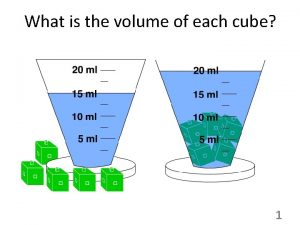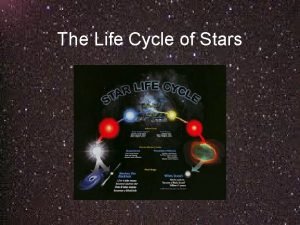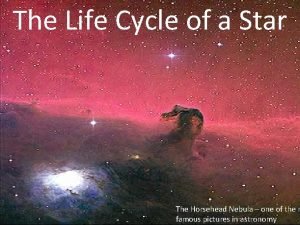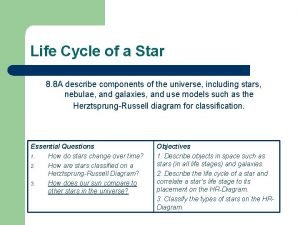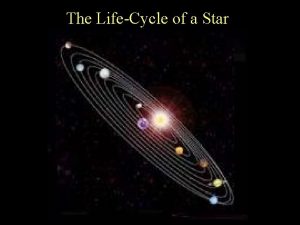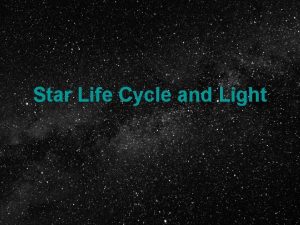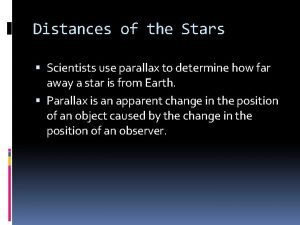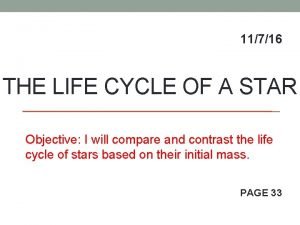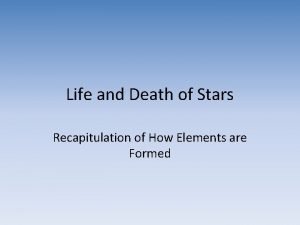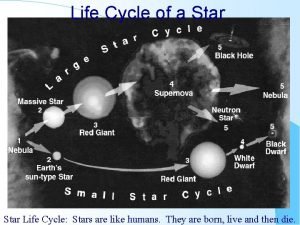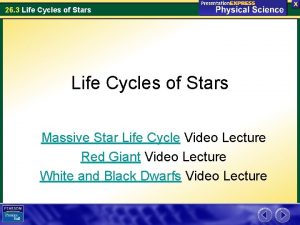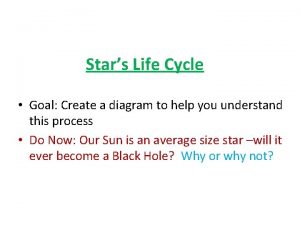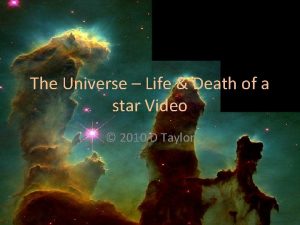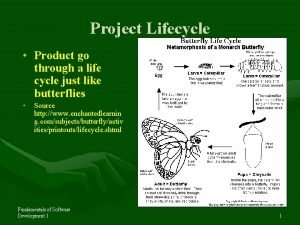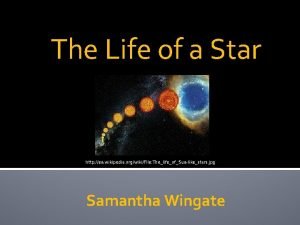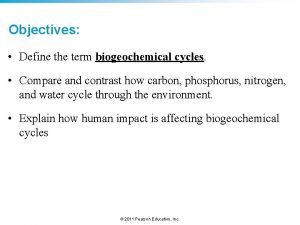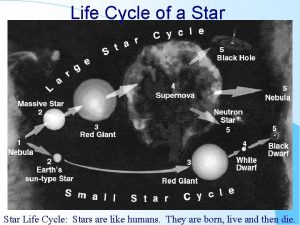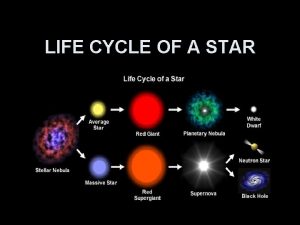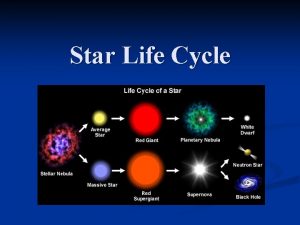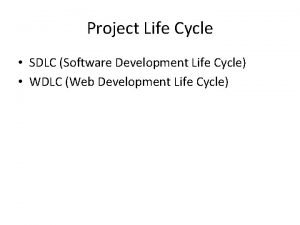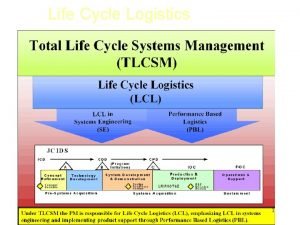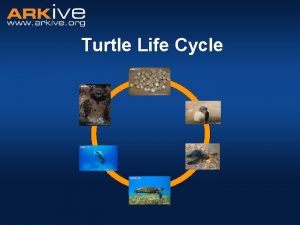Life Cycle of a Star Star Life Cycle





































- Slides: 37

Life Cycle of a Star

Star Life Cycle We do not see this activity when observing the night sky n Shortest-lived O type stars survive for millions of years n

Birth of a Star

Where are stars born? Stages 1 -3 n Our galaxy, along with many others, contains many large clouds of gas and dust, mostly made up of hydrogen. These clouds are called "nebulae. " n If the cloud becomes large enough, then its own gravity begins to overcome the gas pressure, and the cloud can begin to collapse. n

n n As the cloud collapses, gravity, temperature, and pressure increase, until the cloud has collapsed enough to raise the temperature to that required to fuse (burn) the hydrogen. Once that fusion begins, the energy released halts the contraction, and the outer layers of gas are blown away. What's left is an incandescent ball of mostly hydrogen, set aglow by the fusion reactions in its core: a star.

How many particles must accumulate? n Nearly 1057 atoms are required n Much more than the 1027 grains of sand on all the beaches in the world n Even more than the 1051 particles that constitute all atomic nuclei on our planet



Protostar Stage 4 n A forming star is known as a protostar. n A protostar has two possible fates. n 1. If a critical temperature in the core of a protostar is not reached, it ends up a brown dwarf. This mass never makes “star status. ”

Brown Dwarf n A brown dwarf is a protostar that never had enough dust and gas accreted (roughly 0. 05 solar mass) to achieve a temperature hot enough to ignite fusion. It has low mass (it’s not very big), and low luminosity (it doesn’t shine much). It's bigger than a planet, but smaller than a regular star.

Protostar cont. 2. If a critical temperature ( 10, 000 K) in the core of a protostar is reached, then nuclear fusion begins (stages 6). We identify the birth of a star as the moment that it begins fusing hydrogen in the core into helium.



Main Sequence n n Stage 7 Stars live out the majority of their lives in a phase termed as the Main Sequence. n n Because interstellar medium is 97% hydrogen and 3% helium, with trace amounts of dust, etc. , a star primarily burns hydrogen during its lifetime. A medium-size star will live in the hydrogen phase, called the main sequence phase, for about 50 million years. Once hydrogen fuel is gone, the star has entered “old age. ”


Death of a Star

After Main Sequence n n n What happens to a star after the main sequence phase? Old age and death! How long it takes for a star to die depends upon its initial mass. Larger stars have more fuel, but they have to burn (fuse) it faster in order to maintain equilibrium. Because thermonuclear fusion occurs at a faster rate in massive stars, large stars use all of their fuel in a shorter length of time. This means that bigger is not better with respect to how long a star will live. A smaller star has less fuel, but its rate of fusion is not as fast. Therefore, smaller stars live longer than larger stars because their rate of fuel consumption is not as rapid.

Red Giant n n Stages 8 -11 Eventually, the hydrogen in the core whose fusion supports the star begins to run out. n n The core becomes mostly helium (the product of hydrogen fusion), and hydrogen burning moves out away from the core, forming a burning shell around the core. When this happens, the core begins to collapse again, but the outer regions of the star are pushed outwards. n The star becomes brighter and cooler. This is the Red Giant stage. When the sun reaches the Red Giant stage, 5 billion years from now, it will likely grow to engulf Mercury, Venus, and the Earth.



Low Mass Star n n If the star has little mass, it may end its life here, throwing off its outer layers, creating a planetary nebula out of its atmosphere, and a hot, dense "white dwarf" out of its core. White dwarfs are extremely small stars with huge densities. n Although some white dwarfs are no larger than the Earth, the mass of such a dwarf can equal 1. 4 times that of our sun. A spoonful of white dwarf matter would weigh several tons.


Planetary Nebula n The white dwarf is surrounded by an expanding shell of gas in an object known as planetary nebula (stage 12). n n n They are called this because early observers thought they looked like the planets Uranus and Neptune. Planetary nebulae seem to mark the transition of a medium mass star from red giant to white dwarf (stage 13). Eventually, the star will cool down, radiating heat into space, fading into black lumps of carbon. This is when the star becomes a black dwarf (stage 14).


Nova n n n Latin for “new” White dwarf star undergoing an explosion on its surface May increase brightness 10, 000 times in a matter of days If the white dwarf is part of a binary system, its gravitation may pull in hydrogen from neighboring star. The stolen gas will begin fusing causing a sudden flare of luminosity until the fuel is exhausted


High Mass Star n n Fate has something very different, and very dramatic, in store for stars which are some 5 or more times as massive as our Sun. Following the red giant phase, the outer layers of the star swell into a red supergiant (i. e. , a very big red giant), and the core begins to yield to gravity and starts to shrink. As it shrinks, it grows hotter and denser, and a new series of nuclear reactions begin to occur, temporarily halting the collapse of the core.

n However, when the core becomes essentially just iron, it has nothing left to fuse (because of iron's nuclear structure, it does not permit its atoms to fuse into heavier elements) and fusion ceases. In less than a second, the star begins the final phase of its gravitational collapse.

High Mass Star cont. n The core temperature rises to over 100 billion degrees as the iron atoms are crushed together. n n The repulsive force between the nuclei overcomes the force of gravity, and the core recoils out from the heart of the star in an explosive shock wave. As the shock encounters material in the star's outer layers, the material is heated, fusing to form new elements and radioactive isotopes.

Supernova n In one of the most spectacular events in the Universe, the shock propels the material away from the star in a tremendous explosion called a supernova. n The material spews off into interstellar space -perhaps to collide with other cosmic debris and form new stars, perhaps to form planets and moons, perhaps to act as the seeds for an infinite variety of living things.


n n n Unlike in smaller stars, where the core becomes essentially all carbon and stable, the intense pressure inside the supergiant causes the electrons to be forced inside of (or combined with) the protons, forming neutrons. In fact, the whole core of the star becomes nothing but a dense ball of neutrons. It is possible that this core will remain intact after the supernova, and be called a neutron star. However, if the original star was very massive (say 15 or more times the mass of our Sun), even the neutrons will not be able to survive the core collapse and a black hole will form!

Neutron Star Neutron stars are typically about ten miles in diameter and spin very rapidly (one revolution takes mere seconds!). n Neutron stars are fascinating because they are the densest objects known. n Due to its small size and high density, a neutron star possesses a surface gravitational field about 300, 000 times that of Earth. n


Black Holes n n Black holes are objects so dense that not even light can escape their gravity and, since nothing can travel faster than light, nothing can escape from inside a black hole. Nevertheless, there is now a great deal of observational evidence for the existence of two types of black holes: n n those with masses of a typical star (4 -15 times the mass of our Sun), and those with masses of a typical galaxy. This evidence comes not from seeing the black holes directly, but by observing the behavior of stars and other material near them.


Discovery Streaming Stars of the Universe: Grand Tour
 Star of wonder star of night star of royal beauty bright
Star of wonder star of night star of royal beauty bright What are the three major watersheds in virginia
What are the three major watersheds in virginia Protostar phase
Protostar phase Life cycle of a medium sized star
Life cycle of a medium sized star Life cycle of stars
Life cycle of stars Life cycle of a star
Life cycle of a star Star life cycle chart
Star life cycle chart Disadvantages of spiral model
Disadvantages of spiral model Low mass star life cycle
Low mass star life cycle Star lifecycle model
Star lifecycle model Stages of star life cycle
Stages of star life cycle H
H Seasky.org cosmic
Seasky.org cosmic Star life cycle from birth to death
Star life cycle from birth to death The life cycle of a star nebular hypothesis
The life cycle of a star nebular hypothesis 1995 january 23 nasa
1995 january 23 nasa Stellar evolution flowchart
Stellar evolution flowchart Star life cycle from birth to death
Star life cycle from birth to death Step by step life cycle of a star
Step by step life cycle of a star Subgiant star life cycle
Subgiant star life cycle Life cycle of a star
Life cycle of a star Star life cycle model in hci
Star life cycle model in hci Life cycle of a star
Life cycle of a star Star life cycle
Star life cycle Concurrent development model advantages and disadvantages
Concurrent development model advantages and disadvantages Medium mass star life cycle
Medium mass star life cycle Conclusion butterfly life cycle
Conclusion butterfly life cycle Section 26.3 life cycles of stars
Section 26.3 life cycles of stars A* vs ao*
A* vs ao* What does star (for star events) stand for
What does star (for star events) stand for Red giant
Red giant The universe life and death of a star
The universe life and death of a star Sunshine.chpc.utah.edu/labs/star life
Sunshine.chpc.utah.edu/labs/star life Why does a star's life expectancy depend on mass
Why does a star's life expectancy depend on mass Life cylce of a star
Life cylce of a star Star life wikipedia
Star life wikipedia How is the carbon cycle similar to the water cycle brainpop
How is the carbon cycle similar to the water cycle brainpop Phosphorus cycle pearson education
Phosphorus cycle pearson education

